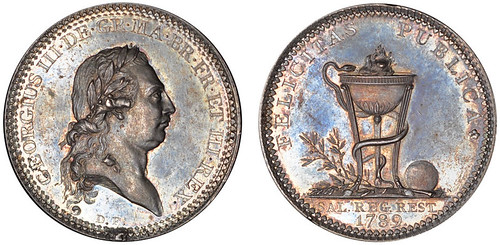
PREV ARTICLE
NEXT ARTICLE
FULL ISSUE
PREV FULL ISSUE
KING GEORGE'S RECOVERYDavid Pickup's latest article in his series on health and coins is about the recovery of King George III. Thank you! We illustrated an example of one of the Recovery medals back in April, and now we have the story. -Editor 
Continuing with stories about health and coins this week we turn to a royal recovery. King George III had a long reign but did not enjoy the best of health. A number of different diagnoses have been suggested including the genetic disease porphyria which can cause mental health symptoms possibly produced by arsenic poisoning or alternatively the mental illness called bipolar affective disorder. He first became ill in 1765 and had a longer episode in 1788. In an effort to get a cure he went to a Midlands town called Cheltenham Spa to take the medicinal waters but his condition worsened. In November he became seriously ill, sometimes speaking continually for many hours, foaming at the mouth, and repeating himself. Treatment for mental illness even for a king was very basic. It consisted of forcible restraint and chemical poultices to draw out "evil humours". His bad health led to a political crisis and a debate about who should be Regent. Fortunately George III recovered and the issue was put to one side. It was his idea to have a public celebration although his own government was not keen. The ceremony was intended to be like a coronation service and the king planned part of it himself. The main event was held at St. Paul's Cathedral in London on 23rd April 1789. Over twenty different types of medallions were issued to mark the event in various sizes and metals. Some very rare ones were presented to senior officials and to Queen Charlotte. Others in gold and silver were presented to the patrons of the "charity children" who attended the church service. Designs featured the coat of arms of London; St Paul's cathedral and another an image of a well at Cheltenham Spa which the king had visited when in search of a cure. (A bit of advertising do you think? They did not mention the fact the the cure had not been successful.)
One of the medals has the inscription,
Edward Thurlow was a politician who during a speech in the House of Commons said: "God forget me when I forget my sovereign". Laurence Brown says these were medals were distributed to children in Windsor, eight of whom had been clothed by the Queen for the celebration, and went in procession from the Town Hall to Windsor parish church. Their medals were pierced and hung round their necks on an orange ribbon. King George was religiously devout and devoted to his family. He was generally popular although best known as the last king of America. Sadly the colonies were not recovered and George's health later deteriorated. He developed dementia, and his sight and hearing with affected. He was unaware of important events including family bereavements and he died in 1820.
To read the earlier E-Sylum articles, see:
Wayne Homren, Editor The Numismatic Bibliomania Society is a non-profit organization promoting numismatic literature. See our web site at coinbooks.org. To submit items for publication in The E-Sylum, write to the Editor at this address: whomren@gmail.com To subscribe go to: https://my.binhost.com/lists/listinfo/esylum All Rights Reserved. NBS Home Page Contact the NBS webmaster 
|